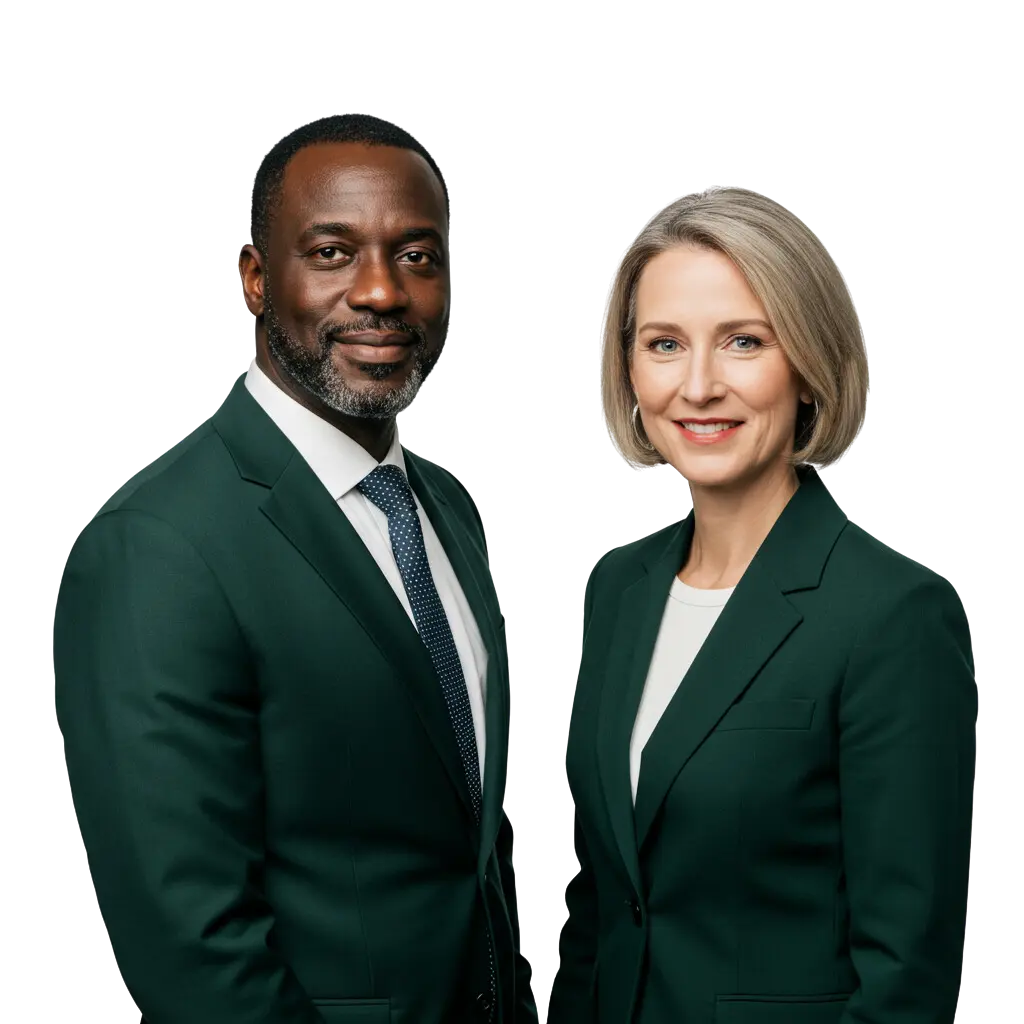Most professionals chase prospects. Strategists build exponential collaboration.
The Question That Changed Everything
My wealth advisor client transformed his entire practice by providing one simple question to his referral partner for their client review meetings:
“Are your earnings on track for you to reach your retirement goals?”
It was a natural question in the conversation about salary, benefits and other requirements in moving to a new role for an executive recruiter.
But this single question opened the door to a strategic partnership that now generates a steady stream of high-net-worth prospects for both him and his executive recruiter partner.
When C-suite clients mention they’re considering new opportunities or feeling undervalued in their current role, the wealth advisor naturally introduces them to his recruiter partner for a confidential market assessment. The recruiter, in turn, regularly encounters executives who express frustration with advisors who don’t understand equity compensation or executive benefits, and refers them back to the wealth advisor.
The result? What started as two professionals working separately in the same market became a multiplication engine generating exponential opportunities for both.
This isn’t traditional networking. This is practice collaboration in action—where strategic partnerships create compound growth that far exceeds what either professional could achieve alone.
Too many professionals treat networking as a numbers game: attend more events, send more LinkedIn messages, host more seminars. But the real opportunity lies in understanding the exponential math of strategic collaboration and identifying the “Super Connectors” who encounter your ideal prospects during their most receptive moments.
The Exponential Math of Strategic Networking
The Fundamental Shift from Linear to Exponential
Staying with my client as an example…
Traditional wealth management business development follows a linear path. You meet someone, exchange cards, maybe schedule a discovery meeting. One connection potentially leads to one client.
Strategic networking operates exponentially. One well-chosen partnership creates a systematic referral engine that generates ongoing prospects for years.
One relationship to build credibility and trust that leads to many, many opportunities to borrow their influence.
The difference is profound:
Linear Networking: Individual introductions that may or may not convert, requiring constant prospecting effort to maintain growth.
Exponential Networking: Strategic partnerships that create ongoing referral streams, with each successful client relationship building credibility for future introductions.
The wealth advisor-recruiter partnership illustrates this perfectly. Instead of the wealth advisor cold-calling prospects or hosting expensive seminars hoping to attract clients, they created an integrated system where their natural client conversations generate opportunities for each other.
Why Traditional Wealth Management Marketing Falls Short
Most advisor marketing fails because it’s built on interruption-based thinking: “Let me tell you why you should move your money to me.” This approach feels forced and often fails because:
- It lacks natural timing – Most people aren’t actively looking to change advisors
- It requires constant promotion – Without systematic processes, lead generation deteriorates
- It creates trust barriers – Cold outreach feels like sales pitches rather than solutions
The Integration Advantage changes this dynamic entirely. When the wealth advisor asks about career trajectory, he’s not making a sales pitch—he’s providing more comprehensive financial counsel. When the recruiter discusses compensation packages, he naturally uncovers frustrations with current advisory relationships. Both professionals become more valuable to their clients through collaboration.
The Power of Strategic Collaboration
True partnerships create three multiplier effects:
Enhanced Credibility: Each partner’s reputation strengthens the other’s. The wealth advisor’s track record lends credibility to the recruiter’s candidate advocacy, and vice versa.
Expanded Service Offering: Clients receive more comprehensive solutions without either professional stepping outside their core competency.
Sustainable Growth: Systematic referrals replace sporadic prospecting efforts, creating predictable new client flow.
Accessing the network of just ONE successful partnership can more than double your book of business (and your partner’s!)
Want to Brainstorm who would be a great collaboration for YOU? Hop into our upcoming ‘SBMO Stop by my Office) conversation’ Registration form HERE
How to Identify “Super Connectors” in Your Market
The Strategic Partner Framework
The key to exponential networking lies in identifying professionals who encounter your ideal prospects during naturally receptive moments. But not just any professional—you need true Super Connectors.
What made the recruiter the perfect partner for the wealth advisor?
- Access to Decision Makers: Regular, intimate conversations with C-suite executives during career transitions
- Natural Timing Advantage: Career moves create natural wealth management evaluation moments
- High Trust Level: Recruiters become trusted confidants during vulnerable career decisions
- Integration Opportunities: Compensation discussions organically connect to wealth management needs
- Outbound Marketing Effort: Not dependent on his competition for their business. The recruiter had a very active and successful marketing effort that produced a large volume of prospects.
Super Connector Identification Criteria
When evaluating potential strategic partners, look for:
Access: Regular, meaningful touchpoints with executives during financially significant moments. The best Super Connectors don’t just know your prospects—they counsel them through major life transitions.
Influence: True trusted advisor status during vulnerable decision-making periods. Career transitions, business sales, succession planning, and major life events create receptive moments.
Reach: A broad network within your target demographic, ideally spanning multiple industries and executive levels.
Alignment: Values and service standards that complement and enhance your comprehensive wealth management approach.
And they are not dependent on others who look *just like* the wealth advisor for their business, this is the biggest challenge with the traditional ‘partnerships’ for financial advisors like estate planning attorneys and CPAs. They have to take from a referral partner to give to another, which is not a good move for them, so they don’t refer anyone.
Go where there’s ‘conflict free’ partnerships.
Strategic Research and Approach
Market Mapping is your first step. Create a comprehensive list of all professionals who encounter high-net-worth individuals during financially significant transitions. For wealth advisors, this includes executive recruiters, business brokers, estate planning attorneys, divorce attorneys, executive coaches, and even luxury real estate agents—anyone who has conversations with executives during change periods.
Value-First Outreach separates strategic networking from transactional approaches. Instead of leading with a partnership proposal, lead with insights that benefit their clients. The wealth advisor initially shared executive compensation trend analysis with recruiters—information that enhanced their candidate counseling.
Partnership Proposal should focus on enhancing client outcomes rather than exchanging leads. The magic phrase: “What if we could both provide more comprehensive guidance during these critical transitions?”
Leveraging Connectors and Influencers for Maximum Reach
The Integration Strategy
Once you’ve identified your Super Connectors, success depends on creating seamless integration between your services.
Natural Conversation Bridges are essential. The career trajectory question works because it flows organically from comprehensive financial planning discussions. Forced referrals feel artificial and damage trust.
Value-Add Positioning frames referrals as service enhancements rather than sales opportunities. When the wealth advisor suggests career counsel, he’s providing better financial guidance, not making a sales pitch.
Trust Transfer leverages existing relationships to accelerate new connections. The recruiter’s candidates trust his judgment about financial matters, so his advisor introduction carries immediate credibility.
Creating Systematic Collaboration
Service Integration goes beyond simple referrals. The recruiter’s insights about a candidate’s career goals and market conditions for executives help the wealth advisor structure optimal compensation and equity strategies. The advisor’s analysis of total compensation packages enhances the recruiter’s negotiation guidance.
Referral Systems make introductions effortless and effective. Both professionals developed natural conversation flows that feel authentic while generating consistent results.
Feedback Loops create information sharing that benefits both partners’ client service. Regular communication about compensation trends and executive sentiment ensures both can provide better counsel.
Mutual Value Creation Principles
The most powerful partnerships go beyond lead exchange to make each other better at core business functions. The wealth advisor became known for understanding career implications of financial decisions. The recruiter became valued for offering comprehensive guidance beyond just their next job. He became a true trusted advisor. .
Market Intelligence Sharing creates additional value. The advisor shares compensation and benefits trends; the recruiter shares executive sentiment and market opportunities.
Joint Authority Building through collaborative thought leadership positions both as comprehensive advisors rather than single-service providers.
Creating Introduction Chains That Compound Over Time
The Network Multiplication Effect
The real power of strategic partnerships emerges when individual client relationships create chains of additional connections.
Chain Reaction Principle: Quality client outcomes generate additional quality referrals. When the recruiter successfully places an executive in a better role, that executive often refers other leaders considering career moves to both professionals.
Trust Amplification: Each successful collaboration increases both partners’ credibility. Success stories become powerful tools for generating additional opportunities.
Systematic Growth: Well-structured partnerships create predictable prospect streams versus the random outcomes of traditional marketing.
Chain Activation Strategies
Success Story Leverage turns positive outcomes into marketing opportunities. Both professionals share appropriate success stories (with permission) that demonstrate the value of their collaboration.
Cross-Promotion through joint content and thought leadership attracts additional prospects while reinforcing both professionals’ expertise.
Network Integration helps partners’ networks connect with each other, creating exponential expansion opportunities.
Building Sustainable Introduction Systems
Process Documentation ensures consistent replication of what works. Both professionals developed conversation templates and referral processes that team members could learn and implement.
Partner Training helps your network understand how to identify good prospects. The more your partners understand your ideal client profile and value proposition, the better referrals they can make.
Quality Control maintains standards that protect everyone’s reputation. Clear criteria for good referrals prevents relationship-damaging mismatches.
Measuring and Optimizing Your Network Effect
Strategic Success Metrics
Traditional wealth management metrics—assets gathered, events hosted, seminars attended—miss the exponential opportunity. Strategic networking requires different measurements:
Partnership Quality: Focus on conversion rates from introductions to new client relationships, not just the number of introductions made.
Compound Growth: Track how partnerships generate additional partnerships over time. The most successful professionals see their referral networks expand exponentially.
Service Enhancement: Measure how collaboration improves your comprehensive planning delivery and client satisfaction scores.
Relationship Velocity: Compare the speed of trust-building through strategic partnerships versus individual prospecting efforts.
Optimization Framework
Partnership Performance requires regular assessment of which collaborations generate the best client relationships. Not all partnerships will be equally productive—focus your energy on the highest-impact relationships.
Process Refinement involves continuous improvement of introduction and follow-up systems based on what generates the best outcomes.
Market Evolution demands adapting partnerships as executive needs and compensation structures change. What works today may need adjustment as markets evolve.
Long-term Strategic Planning
Portfolio Approach: Build multiple strategic partnerships for consistent prospect flow. Relying on a single partnership, no matter how productive, creates vulnerability. Concentration of network is just as dangerous as customer concentration.
Quality vs. Quantity: Focus on deep, productive relationships over broad, shallow networks. Better to have five exceptional partnerships than fifty mediocre connections.
Sustainable Growth: Create systems that scale without requiring constant personal attention. The goal is to build partnerships that generate opportunities even when you’re focused on serving existing clients.
Your Path to Becoming a Super Connector
Step 1: Build Emotional Equity Before Seeking Partnerships
Before seeking partnerships, you must establish yourself as a trusted, comprehensive professional worthy of collaboration.
Trust Foundation requires demonstrating expertise in executive compensation, equity planning, and transition management. The recruiter proved the advisor’s value by experiencing his comprehensive approach to candidate financial guidance before ever making referrals.
One of the most powerful lessons in my course is creating a ‘field trip’ experience through your solution. Making a referral from a first hand experience is why customer referrals are so successful. Create this same opportunity for partners.
Value-First Approach means leading with insights and resources that benefit potential partners’ clients. What do you know about executive compensation, equity strategies, or financial transition planning that would enhance their counsel?
Authentic Relationships focus on genuine collaboration rather than transactional lead exchanges. The best partnerships feel like professional alliances with mutual benefits.
Long-term Perspective involves investing in relationships that will compound over time rather than seeking immediate client acquisitions.
Step 2: Understand Your Ideal Prospect and Their Transition Points
Market Analysis starts with identifying when and where your ideal clients are most receptive to wealth management conversations. Map the entire ecosystem of professionals who encounter executives during change periods.
Transition Moments require understanding the natural points where executives evaluate their financial advisory relationships: career moves, equity events, business sales, divorces, inheritance, retirement planning.
Trust Ecosystem mapping reveals the network of professionals your prospects already depend on during these transitions. These are your potential Super Connectors.
Strategic Positioning helps you understand how comprehensive wealth management fits into executives’ broader transition needs and which partnerships would enhance your value.
Step 3: Go There and Become an Influencer
Authority Building within your partners’ professional networks establishes credibility before seeking collaboration.
Collaborative Leadership involves leading initiatives that benefit the entire professional ecosystem, not just your practice.
Thought Leadership through insights about executive compensation trends and wealth management strategies positions you as a strategic resource rather than just another advisor.
Network Integration means becoming the connector who brings valuable professionals together, establishing yourself as a hub rather than just a service provider.
The Strategic Framework for A Professional Service Practice
This approach works for any advisor by following four key principles:
The Partnership Question: “Who encounters my ideal clients during their most receptive moments?”
The Integration Principle: Find natural bridges between your solution and their professional counsel where collaboration enhances both.
The Enhancement Strategy: Make both services more valuable through collaboration rather than just exchanging leads.
The Multiplication Goal: Create systems that generate ongoing prospects, not just one-time referrals.
The Compound Effect of Strategic Thinking
The wealth advisor-recruiter partnership demonstrates what’s possible when advisors think strategically about business development. Instead of competing for attention in a crowded market, they created a collaborative advantage that benefits everyone: themselves, their partners, and most importantly, their clients.
The key insight: The most successful professionals don’t just build networks—they build practice collaboration. This requires shifting from promotional thinking to strategic collaboration, from prospecting to partnering, from individual marketing to systematic relationship building.
The opportunity exists in every market and every demographic. The question isn’t whether practice collaboration can work for your business development effort—it’s whether you’ll think strategically enough to identify and activate them.
Your next step: Look at your ideal client profile and ask yourself: “Who encounters these executives during their most financially significant transitions?” That’s where your network multiplication begins.
Ready to Build Your Practice Collaboration?
The frameworks in this article provide the strategic foundation, but implementation requires specific tools, processes, and ongoing support.
Join our upcoming open conversation at SBMO (Stop by my Office) for the complete roadmap to identify Super Connectors in your market, create systematic partnership approaches, and build referral systems that generate ongoing prospects. Registration form HERE.
Join SolutionsXChange, our community of progressive trusted advisors who are actively building strategic partnerships and sharing insights about what works. Engage with professionals who understand the difference between marketing and practice collaboration. Link to Group HERE
The practice collaboration multiplier isn’t just a concept—it’s a competitive advantage waiting to be activated in your growth plans.
[Participate in the conversation and join the community →]







